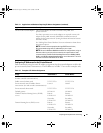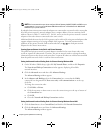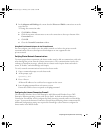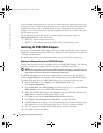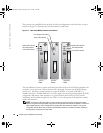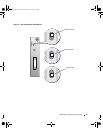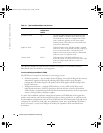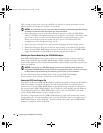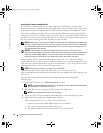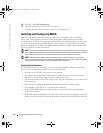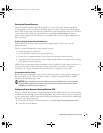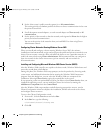
Preparing Your Systems for Clustering 43
In joined-bus and cluster modes, if a secondary EMM receives a message that the primary EMM
has failed, the fault LED indicator on the primary EMM is illuminated and the condition is
reported back to the host initiator. The secondary EMM then becomes active and holds the
failed primary in a state of reset until it is replaced. If the primary EMM detects that the
secondary has failed, the secondary’s fault LED indicator is illuminated and the failed status is
reported back to the host initiator.
NOTE: In split-bus mode, each EMM controls half of the enclosure. If one EMM fails in split-bus mode,
the second EMM reports the failure but does not assume control of the entire SCSI bus.
The primary EMM is always plugged into the slot on the left (viewed from the back of the
system). In a redundant joined-bus configuration, the primary EMM assumes control of all the
enclosure functionality. In addition, the primary EMM is the only module that reports the status
of the system to the host initiator through SES and SAF-TE protocols. Because the secondary
EMM must assume the responsibilities of the primary in the event that the primary fails, both
the primary and secondary EMMs are continuously monitoring the status of the
system’s components.
Preparing the PERC RAID Adapter for Clustering
The warning message shown in Figure 3-3 appears on your screen when you attempt to modify
the configuration of the shared storage system on your cluster by using the PERC RAID adapter
BIOS configuration utility.
Figure 3-3. Important System Warning
The warning message appears on the screen immediately after activating the PERC RAID
adapter BIOS configuration utility by pressing <Ctrl><m> during the system’s Power-On
Self-Test (POST).
!!!STOP!!!
This operation may change the configuration of disks and
can cause loss of data! Ensure:
1.Peer server is powered up for its controller NVRAM to
be updated. Otherwise, disk configuration should be read
from disk and saved to controller's NVRAM.
2.The second server must not be configuring the disks.
3.There is no I/O activity against shared drives.
Press Any Key To Continue
se500wbk1.book Page 43 Thursday, June 16, 2005 4:19 PM



